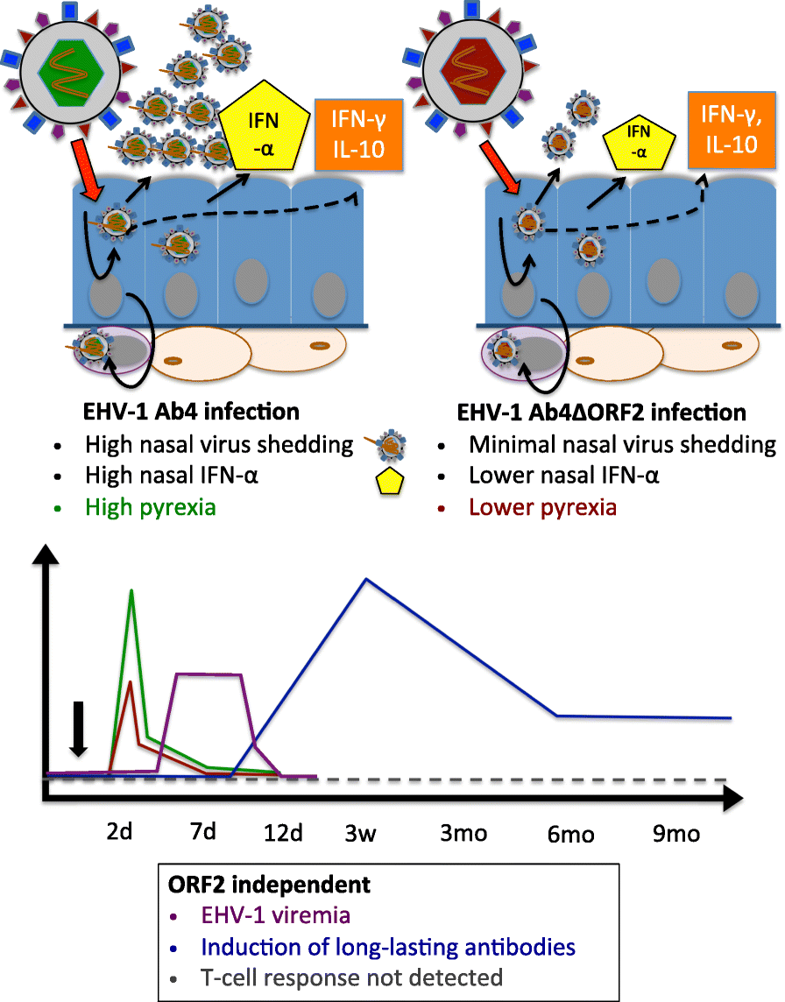Equine Herpes Virus (EHV-1) is a highly contagious respiratory pathogen that is easily spread via horse to horse contact. In mild cases, EHV-1 contraction causes fever, nasal discharge, and lethargy. However, in severe cases, EHV-1 can cause neurological symptoms, and sudden death. The neurologic version of EHV-1 has shown increasing morbidity and mortality in the documented outbreaks since the early 2000s, and appears to be altering its virulence and behavior over time. Thus, the USDA has designated neuropathic EHV-1 as a potentially emerging disease, presenting a serious health risk for horses globally. Unfortunately, existing EHV-1 vaccines do not induce a strong memory response, and therefore require regular boosters to supplement their effects. In addition, there is not an adequate vaccine available for young horses to protect them from the virus early in life. The Wagner lab uses the EHV-1-naïve Icelandic horse model to develop a vaccine that induces longer lasting immune memory, and provide protection in younger foals.

The ORF2 gene (open reading frame 2) of the EHV-1 strain Ab4 is a virulence factor that contributes to fever and viral shedding but does not affect viremia or adaptive host immunity against the virus.
References
Larson EM, Wagner B
Mol Immunol. 2021 Jul;135:329-341. doi: 10.1016/j.molimm.2021.04.013. Epub 2021 May 8.
Schnabel CL, Babasyan S, Rollins A, Freer H, Wimer CL, Perkins GA, Raza F, Osterrieder N, Wagner B
J Virol. 2019 Oct 29;93(22):e01011-19. doi: 10.1128/JVI.01011-19.
Perkins G, Babasyan S, Stout AE, Freer H, Rollins A, Wimer CL, Wagner B
Virology. 2019 May;531:219-232. doi: 10.1016/j.virol.2019.03.014. Epub 2019 Mar 22.
Wimer CL, Schnabel CL, Perkins G, Babasyan S, Freer H, Stout AE, Rollins A, Osterrieder N, Goodman LB, Glaser A, Wagner B
PLoS One. 2018 Nov 15;13(11):e0206679. doi: 10.1371/journal.pone.0206679.
Schnabel CL, Wimer CL, Perkins G, Babasyan S, Freer H, Watts C, Rollins A, Osterrieder N, Wagner B
BMC Vet Res. 2018 Aug 22;14(1):245. doi: 10.1186/s12917-018-1563-4.
Wagner B, Perkins G, Babasyan S, Freer H, Keggan A, Goodman LB, Glaser A, Torsteinsdóttir S, Svansson V, Björnsdóttir S
PLoS One. 2017 Jan 3;12(1):e0169072. doi: 10.1371/journal.pone.0169072.
Maternal T-lymphocytes in equine colostrum express a primarily inflammatory phenotype
Perkins GA, Goodman LB, Wimer C, Freer H, Babasyan S, Wagner B
Vet Immunol Immunopathol. 2014 Oct 15;161(3-4):141-50. doi: 10.1016/j.vetimm.2014.07.009. Epub 2014 Aug 2.
Immunological correlates of vaccination and infection for equine herpesvirus 1
Goodman LB, Wimer C, Dubovi EJ, Gold C, Wagner B
Clin Vaccine Immunol. 2012 Feb;19(2):235-41. doi: 10.1128/CVI.05522-11. Epub 2011 Dec 28.
Wagner B, Wimer C, Freer H, Osterrieder N, Erb HN
Vet Immunol Immunopathol. 2011 Sep 15;143(1-2):116-24. doi: 10.1016/j.vetimm.2011.06.032. Epub 2011 Jun 28.
Equine herpesvirus type-1 modulates CCL2, CCL3, CCL5, CXCL9, and CXCL10 chemokine expression
Wimer CL, Damiani A, Osterrieder N, Wagner B
Vet Immunol Immunopathol. 2011 Apr 15;140(3-4):266-74. doi: 10.1016/j.vetimm.2011.01.009. Epub 2011 Jan 26.
Rosas CT, Tischer BK, Perkins GA, Wagner B, Goodman LB, Osterrieder N
Virus Res. 2007 Apr;125(1):69-78. Epub 2007 Jan 22.
Goodman LB, Wagner B, Flaminio MJ, Sussman KH, Metzger SM, Holland R, Osterrieder N
Vaccine. 2006 Apr 24;24(17):3636-45. Epub 2006 Feb 13.